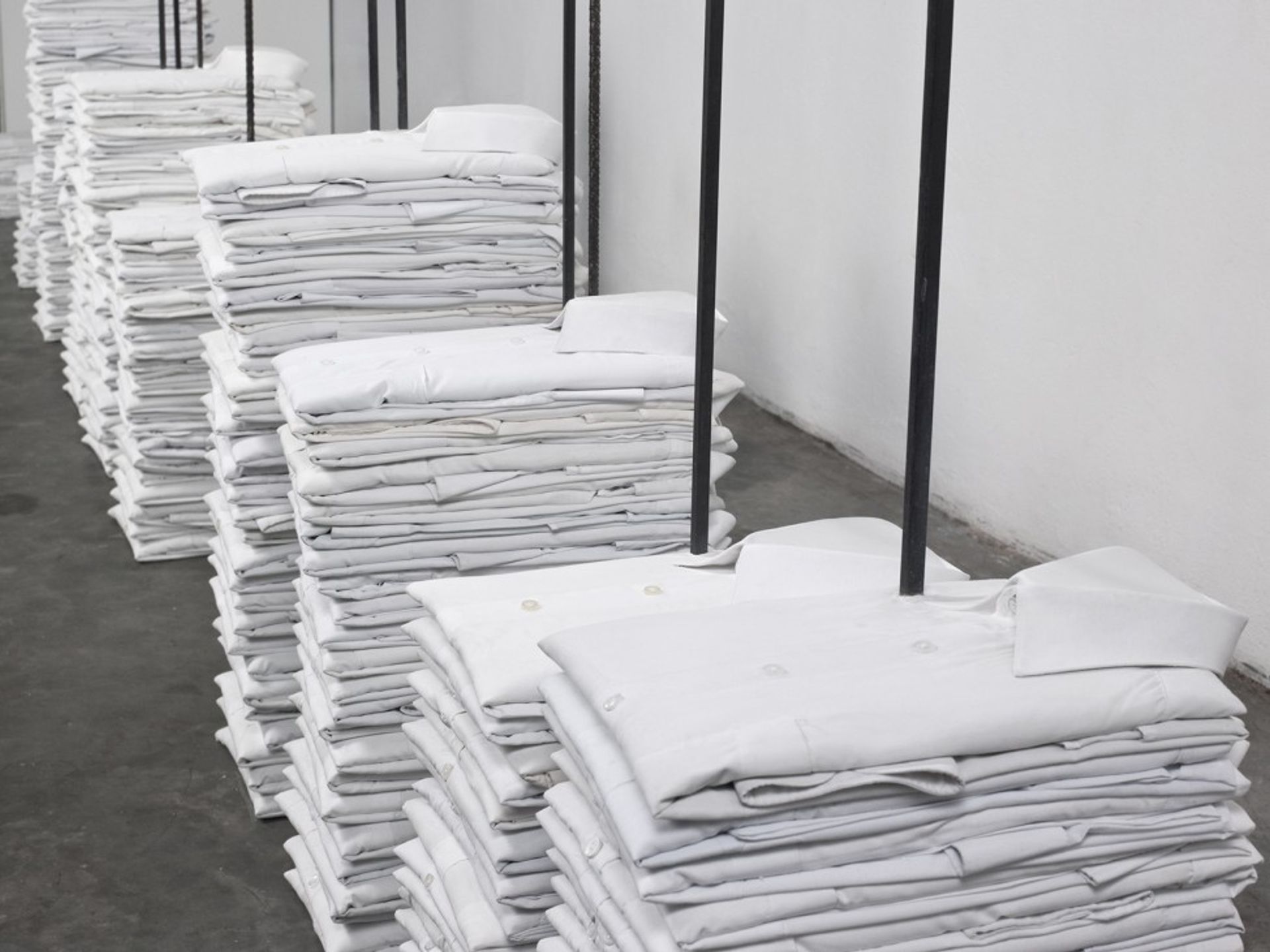The work of the Colombian sculptor Doris Salcedo, one of our most thoughtful contemporary artists, is born of grief. For the past 30 years, Salcedo (whose retrospective is now on view at the Guggenheim Museum in New York, until 12 October) has been publicly mourning the estimated 220,000 Colombians who have been killed in the country’s 50-year civil war. Her art commemorates specific episodes in the history of violence: the forced disappearance of banana plantation workers (as in her untitled piece of 1989, where stacks of neatly-pressed, collared white shirts are pierced through with steels rods), the murder, by Marxist guerrillas, of 11 government deputies from the Valle del Cauca Department (in 2007, Salcedo and a group of artists put nearly 24,000 candles in the Plaza de Bolívar in Bogotá in a temporary memorial titled Acción de Duelo) or the more than 100 people killed in the siege of the Palace of Justice in Bogotá in 1985 (on the 17th anniversary of the attack in 2002, Salcedo slowly lowered a chair for each of the victims from the roof of the building in a work titled Noviembre 6 y 7).
It is tempting to call this work symbolic, but symbols cannot be invented by individuals; they must be agreed upon by a culture. Symbols emerge by consensus. They are historical treaties. And in a world where “war is the main event of our time,” as Salcedo once told the curator Susan Sollins, there is little consensus. Although she begins with what she inherits (“everything precedes me”, she said in a 1998 interview, adding: “my themes are given to me, reality is given to me, the presence of each victim imposes itself”), Salcedo knows that readymade symbolism is made impossible by violent disagreement. She takes seriously Walter Benjamin’s proposal, made in 1940, that “to articulate what is past does not mean to recognize ‘how it really was’. It means to take control of a memory, as it flashes in a moment of danger.”

In Salcedo’s work, symbolism is broken. Her 2007 project for Tate Modern in London, where she split the floor of the Turbine Hall with a 550 foot-long crack, was titled Shibboleth after an episode in the Book of Judges, in which the Gileadites sorted enemy Ephraimites from their ranks by listening closely to their accents. Forty-two thousands Ephraimites unable to properly pronounce “shibboleth” were killed. As a metaphor, Salcedo’s piece worked well: it sorted museum visitors into two camps. Some liked it and some did not. (“It’s a real shame that London’s infrastructure has fallen apart to the extent that there are giant cracks in one of its newest museums,” one sarcastic visitor told a reporter from the New York Times.) The work made a virtue of disagreement, as all modern art does.
But even disagreement relies on at least two parties, and some things are truly done alone. Mourning is one of them. Even when it is public, sorrow is an invisible movement of the mind. Grief is not unlike artistic intention, which is similarly invisible. Every artist needs her reasons to work, but purposes are personal. An artist’s motivations, whatever they are, have no relevance to the public; all we can see are the results. Salcedo is the rare artist who is willing to concede this fact. In 2003, speaking of her untitled project for the eighth Istanbul Biennial, where she amassed 1,550 wooden chairs in an empty lot between two buildings, she said that the installation came from “a violent past where Jews and Greeks were forced out of their buildings, these buildings.” But this was something only she needed to know. It was just the beginning of her work. “I don’t think it’s important to know the event,” Salcedo added. “I’m not narrating a particular story. I’m just addressing experiences.”

Salcedo buries particular stories. Her best sculptures are a group of simple, untitled works made between 1989 and 2008. Each is made from an armoire, dresser, chest or chair filled with poured concrete. Sometimes, pieces are fitted together oddly: a chair inside a wardrobe, a bedframe inside a dresser. In some cases, the furniture comes directly from the families of Colombian victims. Some pieces even have old clothes entombed in the concrete. But what can these handsome, Minimalist works teach us about forced abductions or the lives of victims? What do they say about sorrow? It does not make sense to say, as Karen Wilkin does in the Wall Street Journal, that Salcedo’s work “generate[s] a solemn, elegiac mood”. The opposite is true: solemnity is the beginning, not the end. Salcedo finds inspiration in mourning, but she then channels it into new inventions.
Salcedo’s art is disproportionately affected by the context in which it is made. What would her work look like without 50 years of violence in Colombia? It is impossible to picture. When Salcedo says that war is the main event of our time, she means exactly this: that it herds the imagination. It shatters symbolism and consensus, and makes the world violently disagreeable. The costs are enormous, and in Colombia, the toll is still rising. In 2010, 2,000 bodies were found in a plot south of Bogotá near a military base. The government admitted to burying the group, claiming they were rebels. Art is a small solace for all this lost life, but Salcedo makes her sorrow worthwhile. She makes mourning into its own reward.
See our feature-length interview with the artist from our July/August 2015 issue.
Pac Pobric is Assistant Editor for reviews and exhibitions at The Art Newspaper.
Doris Salcedo, Guggenheim Museum, New York, until 12 October

